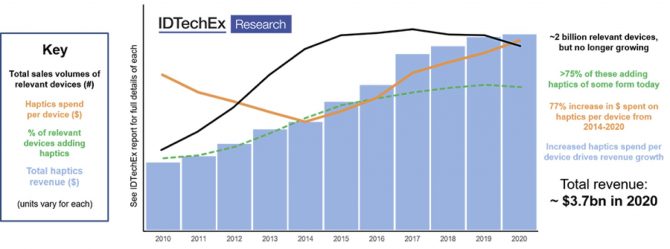
2021 – A critical year for haptics
By IDTechEx, Cambridge, UK
Automation / Robotics Electronics Editor Pick haptics hardware softwareNew technology options mature, says research from IDTechEx
As companies compete to release the best new electronic devices, differentiation from the competition comes from the different features and components that a device can offer. Investment in these different components differs over time; in any particular year or product cycle, a player can differentiate from the increasingly busy crowd by winning with a specific component or feature development, enabling it to stand out.

Source: Getty Images
This could be an advanced camera or image recognition processor, 5G connectivity, or a brand-new display or interface. Haptics is one of the more unsung heroes amongst these components, but whilst it rarely makes headlines, it contributes significantly to the overall experience of using devices. Investment and development in haptics is accelerating, and the supply chain providing the actuators, drivers and software behind these key components is evolving at a faster pace every year.
Haptics are being explored in vehicular interfaces
The smartphone dominates the market for haptics in terms of volume. However, it is in other industry sectors and products where newer, more advanced haptics often find their feet first. Some of the most advanced haptics have been developed for military use, for controlling high-end industrial equipment, or the most advanced surgical robotic assistants. Haptics are being explored in vehicular interfaces, replacing mechanical buttons and using the sense of touch for a safer, more reliable interface to the driver. It is also fundamental to VR, AR & MR, where haptic feedback serves the sense of touch, just as the displays and optics serve sight or the audio feedback serves hearing. Finally, perhaps the best known and most significant sector outside of smartphones comes within console gaming, where controllers deploy haptics to enhance player immersion, as exemplified with Sony’s significant new investment into haptics within the DualSense controllers for PlayStation 5.

With new haptics being integrated into products spanning several industry verticals, 2021 is a critical year for this industry. Many options for new technologies are approaching maturity, and IDTechEx expect production efforts for the next generation of actuators for key markets such as smartphones to be ramped up within the next 1-2 years. New commercialization drives new interest into the next generation of haptics, fuelling additional investment into parallel technologies, which may serve as alternatives or future options for these lucrative consumer product markets. It also drives enhanced user expectations in haptic feedback, which impacts other haptics markets, from industrial applications to automotive interfaces.
All of the hardware then relies on driver software
This investment in haptics drives progress throughout the value chain. Needs from end-users in various industries are met by an array of different players with different roles. Core component manufacturers rely on materials suppliers and manufacturing processes for the latest component development. Actuators themselves then only work as well as the actuators which drive them. All of the hardware then relies on driver software and tools which allow developers to integrate haptic effects within specific device applications. The result is a diverse ecosystem, driven by megatrends around enhanced interaction between humans and machines, but with more specific drivers within each market vertical.
IDTechEx’s latest report on haptics predicts that the industry will be worth nearly $5bn in 2025. The report is based on extensive primary research, with more than 30 interviews with leading players from throughout the value chain. This is supported by a narrative and content developed over more than 5 years of covering the industry, including historic market data from 2010-2020, market forecasts from 2021-2031, and, for the first time, supporting databases of companies and products in the haptics. This report serves as a critical guide to anyone participating in, investing in, or considering the strategic importance of the provision of haptic feedback within products today.
More information can be found at www.IDTechEx.com/Haptics.
